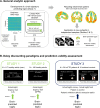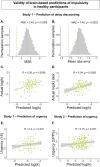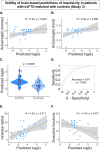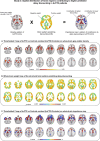This is a preprint.
A structural MRI marker predicts individual differences in impulsivity and classifies patients with behavioral-variant frontotemporal dementia from matched controls
- PMID: 39345385
- PMCID: PMC11429931
- DOI: 10.1101/2024.09.12.612706
A structural MRI marker predicts individual differences in impulsivity and classifies patients with behavioral-variant frontotemporal dementia from matched controls
Abstract
Impulsivity and higher preference for sooner over later rewards (i.e., delay discounting) are transdiagnostic markers of many psychiatric and neurodegenerative disorders. Yet, their neurobiological basis is still debated. Here, we aimed at 1) identifying a structural MRI signature of delay discounting in healthy adults, and 2) validating it in patients with behavioral variant frontotemporal dementia (bvFTD)-a neurodegenerative disease characterized by high impulsivity. We used a machine-learning algorithm to predict individual differences in delay discounting rates based on whole-brain grey matter density maps in healthy male adults (Study 1, N=117). This resulted in a cross-validated prediction-outcome correlation of r=0.35 (p=0.0028). We tested the validity of this brain signature in an independent sample of 166 healthy adults (Study 2) and its clinical relevance in 24 bvFTD patients and 18 matched controls (Study 3). In Study 2, responses of the brain signature did not correlate significantly with discounting rates, but in both Studies 1 and 2, they correlated with psychometric measures of trait urgency-a measure of impulsivity. In Study 3, brain-based predictions correlated with discounting rates, separated bvFTD patients from controls with 81% accuracy, and were associated with the severity of disinhibition among patients. Our results suggest a new structural brain pattern-the Structural Impulsivity Signature (SIS)-which predicts individual differences in impulsivity from whole-brain structure, albeit with small-to-moderate effect sizes. It provides a new brain target that can be tested in future studies to assess its diagnostic value in bvFTD and other neurodegenerative and psychiatric conditions characterized by high impulsivity.
Keywords: brain signature; decision-making; delay discounting; dementia; intertemporal choice; machine-learning; prediction.
Figures





References
-
- Chamberlain S. R. & Sahakian B. J. The neuropsychiatry of impulsivity. Curr. Opin. Psychiatry 20, 255–261 (2007). - PubMed
-
- Goodwin B. C., Browne M., Hing N. & Russell A. M. Applying a revised two-factor model of impulsivity to predict health behaviour and well-being. Personal. Individ. Differ. 111, 250–255 (2017).
-
- Rogers M. M., Kelley K. & McKinney C. Trait impulsivity and health risk behaviors: A latent profile analysis. Personal. Individ. Differ. 171, 110511 (2021).
-
- Bjork J. M., Momenan R. & Hommer D. W. Delay discounting correlates with proportional lateral frontal cortex volumes. Biol. Psychiatry 65, 710–713 (2009). - PubMed
Publication types
Grants and funding
LinkOut - more resources
Full Text Sources
Medical
